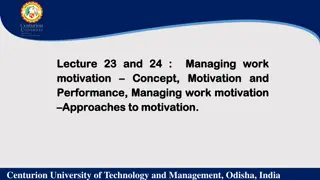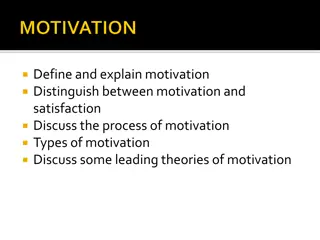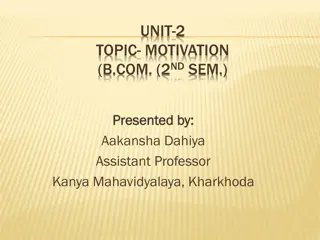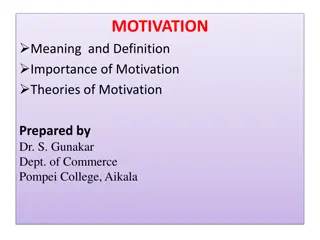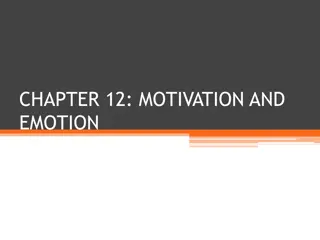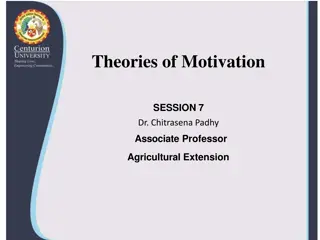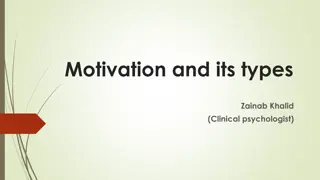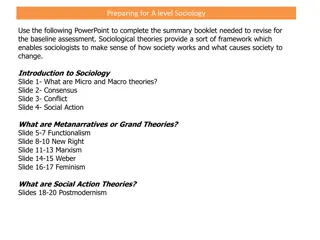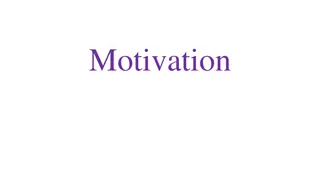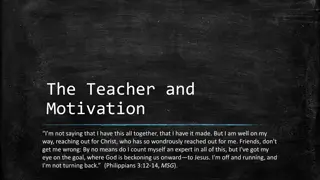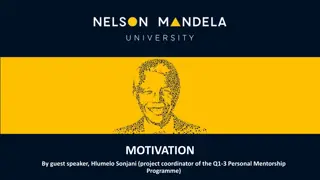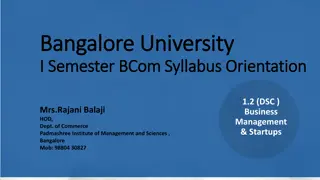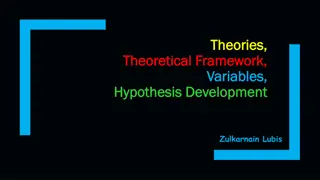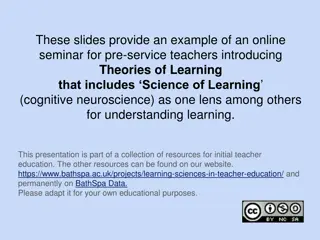Understanding Motivation in Business: Methods and Theories
Motivation in business plays a crucial role in employee engagement and productivity. This excerpt delves into both monetary and non-monetary methods of motivation, such as fringe benefits, bonuses, job rotation, empowerment, and more. By understanding the different approaches to motivating employees, businesses can enhance productivity, quality, and overall organizational success.
Uploaded on Sep 11, 2024 | 0 Views
Download Presentation

Please find below an Image/Link to download the presentation.
The content on the website is provided AS IS for your information and personal use only. It may not be sold, licensed, or shared on other websites without obtaining consent from the author. Download presentation by click this link. If you encounter any issues during the download, it is possible that the publisher has removed the file from their server.
E N D
Presentation Transcript
Motivation EXTRAIT DU DIAPORAMA DISPONIBLE SUR LE SITE THE TIMES 100 BUSINESS CASE STUDIES (VIRGIN)
What is motivation? Motivation is concerned with the desire to do something or achieve a particular result. Having motivated employees results in: Greater productivity Better quality products or service Lower staff turnover Reduced absenteeism
Monetary methods of motivation Fringe benefits Examples include company cars and discount vouchers. May not encourage greater productivity but often build company loyalty. Bonuses A payment usually related to the achievement of a target. Usually easier to apply to sales or production rather than the provision of a service. Profit share Employees are encouraged to ensure that the business is profitable. However it is usually spread evenly between both hard-working and less hard-working staff.
Monetary methods of motivaiton Commission Payments are made in relation to the number or value of sales made. Encourages increased sales but may lead to heavy-handed selling techniques. Piece rate Payments are made per item produced. Encourages productivity but sometimes at the expense of quality. Overtime Additional payment made for extra hours worked. Can provide greater flexibility to the workforce but may result in lower productivity during normal working hours if employees know they can access overtime payments.
Non-monetary methods of motivation Job rotation Employees move between different jobs, e.g. on a production line. Results in flexible, multi-skilled staff but ultimately workers may just be moving from one boring job to another. Workers are given a wider variety of different tasks to carry out although there is no increase in the level of responsibility. This is sometimes called horizontal loading. Giving employees the chance to fully utilise their abilities through, for example, providing a range of challenges, training workers and allowing them to demonstrate their skills. Job enlargement Job enrichment
Non-monetary methods of motivation Empowerment Allowing workers greater autonomy. They have greater freedom and power to control their own working lives. Team-working Involves organising workers into groups, setting team goals and awarding team rewards for achieving targets. Team-working fits with Mayo s findings. Participation Employees participate in organisational decision- making through such things as quality circles and works councils.
Motivational theorists It is useful to know 2 or 3 motivational theories from the following list: Maslow s hierarchy of needs Mayo s theory of human relations
Abraham Maslow Abraham Maslow was an American psychologist. He fully introduced his hierarchy of needs in 1954 to explain how people are motivated. Although Maslow s theory was not intended to apply only to the workplace, it has practical applications in business.
Maslows hierarchy of needs Self actualisation Self esteem Social Safety Physiological
Maslows hierarchy of needs The hierarchy starts with our basic physiological needs for survival. As each need is met, the next need up the hierarchy becomes the motivator. Workplaces can help to meet these needs.
Maslow and the workplace Maslow s needs Examples of how these may be met in the workplace Pay Decent working conditions Health and safety provision Job security Staff room Team-working opportunities Recognition e.g. Employee of the month The chance to make a difference Training Opportunities for promotion and career progression Physiological/Basic Safety Social Self-esteem Self-actualisation
However... One criticism of Maslow s hierarchy is that workers may not seek to have all their needs met in the workplace. For example, if a worker has a hectic social and family life, they may not need to have their social needs met at work. Some researchers have questioned the order that Maslow has given the needs, whereas others even question the existence of a hierarchy at all.
Elton Mayo the human relations movement
Elton Mayo Elt0n Mayo was a psychology lecturer in Australia and the USA during the early part of the 20thcentury. Mayo s human relations school of management theory came out of a study he carried out at Western Electric company s Hawthorne Plant in Chicago.
Mayos theory of human relations Mayo s experiments showed that: teamwork is an important motivator managers should take an interest in their workers. He suggested the physical conditions and pay matter less than social interaction when motivating employees.
Humans relations and firms According to Mayo, workers will be motivated if given the opportunity to: Work in teams Get involved in the direction and decision making of the organisation Access effective communication channels with managers and other workers.



